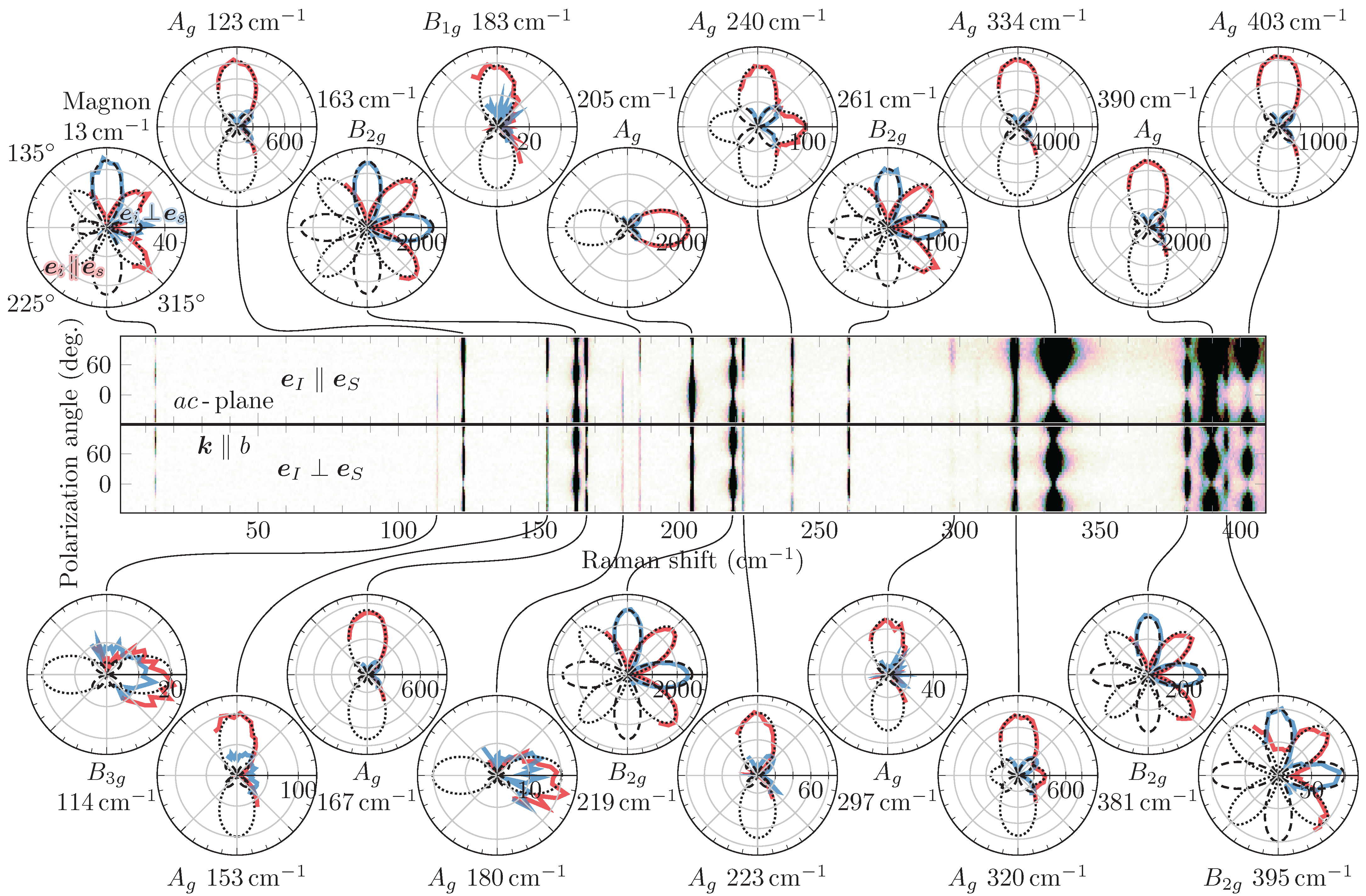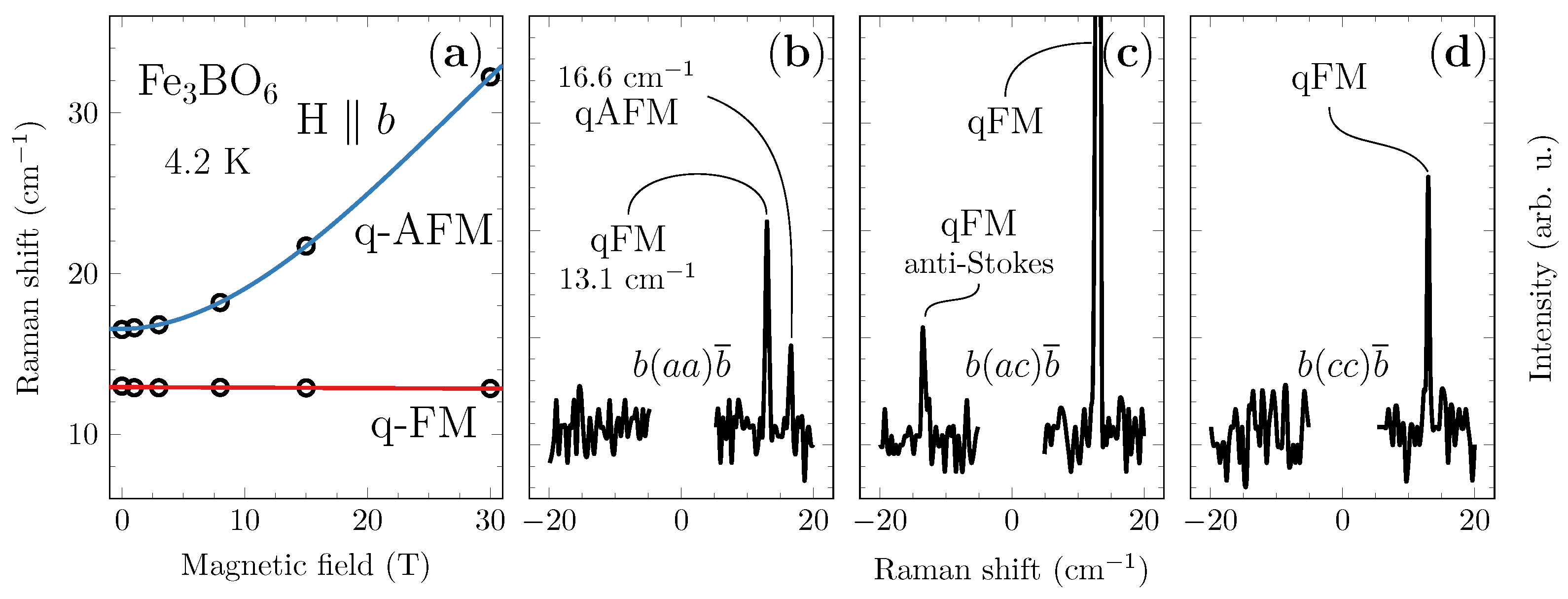High-Field Raman Scattering in an Antiferromagnet Fe3BO6
Abstract
:1. Introduction
2. Materials and Methods
3. Results
3.1. Lattice Dynamics
3.2. Spin Dynamics
4. Discussion
5. Conclusions
Author Contributions
Funding
Institutional Review Board Statement
Informed Consent Statement
Data Availability Statement
Acknowledgments
Conflicts of Interest
References
- Rowsell, J.L.C.; Gaubicher, J.; Nazar, L.F. A New Class of Materials for Lithium-Ion Batteries: Iron(III) Borates. J. Power Sources 2001, 97–98, 254–257. [Google Scholar] [CrossRef]
- Shi, X.; Chang, C.; Xiang, J.; Xiao, Y.; Yuan, L.; Sun, J. Synthesis of Nanospherical Fe3BO6 Anode Material for Lithium-Ion Battery by the Rheological Phase Reaction Method. J. Solid State Chem. 2008, 181, 2231–2236. [Google Scholar] [CrossRef]
- Ram, S.; Kumari, K.; Kotnala, R.K. Synthesis of Norbergite Fe3BO6 of Single Crystallites from a Borate Glass. Trans. Indian Ceram. Soc. 2010, 69, 165–170. [Google Scholar] [CrossRef]
- Tian, J.; Wang, B.; Zhao, F.; Ma, X.; Liu, Y.; Kun Liu, H.; Huang, Z. Highly Active Fe3BO6 as an Anode Material for Sodium-Ion Batteries. Chem. Commun. 2017, 53, 4698–4701. [Google Scholar] [CrossRef] [PubMed]
- Kumari, K. Structural, Vibrational and Surface Analysis of Fe3BO6 Nanoplates Synthesized by Combustion Method. J. Mol. Struct. 2018, 1165, 293–298. [Google Scholar] [CrossRef]
- Kumari, K.; Ram, S.; Kotnala, R.K. Self-Controlled Growth of Fe3BO6 Crystallites in Shape of Nanorods from Iron-Borate Glass of Small Templates. Mater. Chem. Phys. 2011, 129, 1020–1026. [Google Scholar] [CrossRef]
- Kalashnikova, A.M.; Kimel, A.V.; Pisarev, R.V.; Gridnev, V.N.; Kirilyuk, A.; Rasing, T. Impulsive Generation of Coherent Magnons by Linearly Polarized Light in the Easy-Plane Antiferromagnet FeBO3. Phys. Rev. Lett. 2007, 99, 167205. [Google Scholar] [CrossRef] [PubMed]
- Abe, M.; Gomi, M.; Nomura, S. Faraday Rotation and Birefringence of Fe3BO6. Jpn. J. Appl. Phys. 1980, 19, 1329. [Google Scholar] [CrossRef]
- Andlauer, B.; Diehl, R. Optical Absorption of Fe3BO6 in the Range of the Transitions 6A1→4T1, 4T2. Phys. B C 1977, 89, 50–53. [Google Scholar] [CrossRef]
- Voigt, C. Field-Induced Phase Transition in Fe3BO6. Phys. Lett. A 1975, 53, 223–224. [Google Scholar] [CrossRef]
- Andlauer, B.; Diehl, R.; Skolnick, M.S. Investigation of the Optical Absorption of Fe3BO6 after Oxygen Annealing and under the Influence of Strong Magnetic Fields. J. Appl. Phys. 1978, 49, 2200–2202. [Google Scholar] [CrossRef]
- White, J.G.; Miller, A.; Nielsen, R.E. Fe3BO6, a Borate Isostructural with the Mineral Norbergite. Acta Crystallogr. 1965, 19, 1060–1061. [Google Scholar] [CrossRef]
- Diehl, R.; Brandt, G. Refinement of the Crystal Structure of Fe3BO6. Acta Crystall. B-Stru. 1975, 31, 1662–1665. [Google Scholar] [CrossRef]
- Wolfe, R.; Pierce, R.D.; Eibschütz, M.; Nielsen, J.W. Magnetization and Mössbauer Effect in Single Crystal Fe3BO6. Solid State Commun. 1969, 7, 949–952. [Google Scholar] [CrossRef]
- Voigt, C.; Bonnenberg, D. Temperature Dependence of the Magnetic Susceptibility of Fe3BO6. Phys. B C 1975, 80, 439–443. [Google Scholar] [CrossRef]
- Nakamura, S.; Mitsui, T.; Kobayashi, Y.; Kurokuzu, M.; Shimomura, S. Synchrotron Mössbauer Diffraction of Natural Iron Fe3BO6. J. Phys. Soc. Jpn. 2020, 89, 125001. [Google Scholar] [CrossRef]
- Hirano, M.; Okuda, T.; Tsushima, T.; Umemura, S.; Kohn, K.; Nakamura, S. Spin Configurations and Spin Reorientations in Pure and Impurity Doped Fe3BO6. Solid State Commun. 1974, 15, 1129–1133. [Google Scholar] [CrossRef]
- Mal’tsev, V.I.; Najden, E.P.; Zhilyakov, S.M.; Smolin, R.P.; Borisyuk, L.M. Magnetic Structure of Fe3BO6. Kristallografiya 1976, 21, 113–117. [Google Scholar]
- Koshizuka, N.; Hirano, M.; Okuda, T.; Nakamura, S.; Hiruma, H.; Tsushima, T. Control of the Spin Reorientation with Impurity Modification in RFeO3 and Fe3BO6. AIP Conf. Proc. 1975, 24, 61–62. [Google Scholar] [CrossRef]
- Tsymbal, L.T.; Bazaliy, Y.B.; Bezmaternykh, L.N.; Slawska-Waniewska, A.; Vasiliev, S.V.; Nedelko, N.; Linnik, A.I.; Cherkasov, A.N.; Nepochatykh, Y.I.; Dmitrenko, V.Y.; et al. Orientation Phase Transition in Fe3BO6: Experimental Determination of the Order of the Transition. Phys. Rev. B 2006, 74, 134429. [Google Scholar] [CrossRef]
- Biryukov, Y.P.; Filatov, S.K.; Vagizov, F.G.; Zinnatullin, A.L.; Bubnova, R.S. Thermal Expansion of FeBO3 and Fe3BO6 Antiferromagnets Near the Neel Temperature. J. Struct. Chem. 2018, 59, 1980–1988. [Google Scholar] [CrossRef]
- Buchelnikov, V.D.; Danshin, N.K.; Dolgushin, D.M.; Izotov, A.I.; Shavrov, V.G.; Tsymbal, L.T.; Takagi, T. Specific Features of Magnetoacoustic Waves in Fe3BO6. Phys. Solid State 2005, 47, 1886–1891. [Google Scholar] [CrossRef]
- Buchelnikov, V.; Danshin, N.; Dolgushin, D.; Isotov, A.; Shavrov, V.; Tsymbal, L.; Kakazei, G.; Takagi, T.; Wigen, P. The Magnetoacoustic Anomaly in Fe3BO6. J. Magn. Magn. Mater. 2004, 272–276, 2113–2114. [Google Scholar] [CrossRef]
- Müllerwiebus, E.U.; Bonnenberg, D. Microwave Resonance in Fe3BO6. Phys. B C 1975, 80, 435–438. [Google Scholar] [CrossRef]
- Harutunian, V.E.; Kocharian, K.N.; Martirosian, R.M.; Voronkov, V.D.; Bezmaternich, L.N. Investigation of Submillimeter-Wave Spin-Precession Modes in Fe3BO6. Int. J. Infrared Milli. 1989, 10, 841–845. [Google Scholar] [CrossRef]
- Navarro, H.; Potts, J.E.; Merlin, R. Raman Scattering from Phonons and Magnons in Antiferromagnetic Fe3BO6. Solid State Commun. 1984, 50, 331–333. [Google Scholar] [CrossRef]
- Prosnikov, M.A.; Smirnov, A.N.; Davydov, V.Y.; Pisarev, R.V.; Lyubochko, N.A.; Barilo, S.N. Magnetic Dynamics and Spin-Phonon Coupling in the Antiferromagnet Ni2NbBO6. Phys. Rev. B 2018, 98, 104404. [Google Scholar] [CrossRef]
- Momma, K.; Izumi, F. VESTA3 for Three-Dimensional Visualization of Crystal, Volumetric and Morphology Data. J. Appl. Crystallogr. 2011, 44, 1272–1276. [Google Scholar] [CrossRef]
- Binder, J.M.; Stark, A.; Tomek, N.; Scheuer, J.; Frank, F.; Jahnke, K.D.; Müller, C.; Schmitt, S.; Metsch, M.H.; Unden, T.; et al. Qudi: A Modular Python Suite for Experiment Control and Data Processing. SoftwareX 2017, 6, 85–90. [Google Scholar] [CrossRef]
- Wojdyr, M. Fityk: A General-Purpose Peak Fitting Program. J. Appl. Crystallogr. 2010, 43, 1126–1128. [Google Scholar] [CrossRef]
- Kranert, C.; Sturm, C.; Schmidt-Grund, R.; Grundmann, M. Raman Tensor Formalism for Optically Anisotropic Crystals. Phys. Rev. Lett. 2016, 116, 127401. [Google Scholar] [CrossRef] [PubMed]
- Fleury, P.A.; Loudon, R. Scattering of Light by One- and Two-Magnon Excitations. Phys. Rev. 1968, 166, 514–530. [Google Scholar] [CrossRef]
- De Jong, J.A.; Razdolski, I.; Kalashnikova, A.M.; Pisarev, R.V.; Balbashov, A.M.; Kirilyuk, A.; Rasing, T.; Kimel, A.V. Coherent Control of the Route of an Ultrafast Magnetic Phase Transition via Low-Amplitude Spin Precession. Phys. Rev. Lett. 2012, 108, 157601. [Google Scholar] [CrossRef] [PubMed]
- Yamaguchi, K.; Kurihara, T.; Minami, Y.; Nakajima, M.; Suemoto, T. Terahertz Time-Domain Observation of Spin Reorientation in Orthoferrite ErFeO3 through Magnetic Free Induction Decay. Phys. Rev. Lett. 2013, 110, 137204. [Google Scholar] [CrossRef] [PubMed]
- Mikhaylovskiy, R.V.; Hendry, E.; Secchi, A.; Mentink, J.H.; Eckstein, M.; Wu, A.; Pisarev, R.V.; Kruglyak, V.V.; Katsnelson, M.I.; Rasing, T.; et al. Ultrafast Optical Modification of Exchange Interactions in Iron Oxides. Nat. Comm. 2015, 6, 8190. [Google Scholar] [CrossRef] [PubMed]
- Mikhaylovskiy, R.V.; Huisman, T.J.; Gavrichkov, V.A.; Polukeev, S.I.; Ovchinnikov, S.G.; Afanasiev, D.; Pisarev, R.V.; Rasing, T.; Kimel, A.V. Resonant Pumping of d-d Crystal Field Electronic Transitions as a Mechanism of Ultrafast Optical Control of the Exchange Interactions in Iron Oxides. Phys. Rev. Lett. 2020, 125, 157201. [Google Scholar] [CrossRef] [PubMed]





| (cm) | Assignment 1 | Tensor Elements 2 | (cm) | (cm) 3 |
|---|---|---|---|---|
| 13.1 | qFM | 7.8 | – | |
| 16.6 | qAFM | – | – | – |
| 113.8 | – | – | 114 | |
| 123.1 | 122.3 | 124 | ||
| 152.9 | 151.2 | 154 | ||
| 163.4 | 162.1 | 164 | ||
| 166.9 | 165.4 | 166 | ||
| 178.1 | – | – | 178 | |
| 179.9 | – | – | ||
| 183.2 | – | – | 184 | |
| 186.1 | – | – | ||
| 204.8 | 203.1 | 204 | ||
| 219.4 | 51 | 217.6 | 218 | |
| 222.9 | – | 221 | ||
| 240.5 | 238.8 | 240 | ||
| 260.7 | 259.0 | 260 | ||
| 281.8 | ? | – | – | – |
| 297.5 | – | 294 | ||
| 306.7 | ? | – | – | – |
| 320.1 | 18.5, 27.5 | 318.8 | 320 | |
| 333.7 | 331.9 | 332 | ||
| 381.4 | 18 | 379.7 | 382 | |
| 390.0 | 387.4 | 388 | ||
| 395.4 | 10 | – | 390 | |
| 402.9 | 400.4 | 400 | ||
| – | – | 427.1 | 428 |
Publisher’s Note: MDPI stays neutral with regard to jurisdictional claims in published maps and institutional affiliations. |
© 2022 by the authors. Licensee MDPI, Basel, Switzerland. This article is an open access article distributed under the terms and conditions of the Creative Commons Attribution (CC BY) license (https://creativecommons.org/licenses/by/4.0/).
Share and Cite
Prosnikov, M.A.; Barilo, S.N.; Liubochko, N.A.; Pisarev, R.V.; Christianen, P.C.M. High-Field Raman Scattering in an Antiferromagnet Fe3BO6. Magnetochemistry 2022, 8, 77. https://doi.org/10.3390/magnetochemistry8080077
Prosnikov MA, Barilo SN, Liubochko NA, Pisarev RV, Christianen PCM. High-Field Raman Scattering in an Antiferromagnet Fe3BO6. Magnetochemistry. 2022; 8(8):77. https://doi.org/10.3390/magnetochemistry8080077
Chicago/Turabian StyleProsnikov, Mikhail A., Sergei N. Barilo, Nadzeya A. Liubochko, Roman V. Pisarev, and Peter C. M. Christianen. 2022. "High-Field Raman Scattering in an Antiferromagnet Fe3BO6" Magnetochemistry 8, no. 8: 77. https://doi.org/10.3390/magnetochemistry8080077





